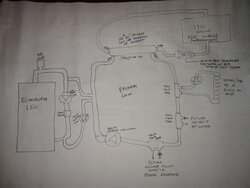I'm still plugging away at planning my system, and will definitely have an unpressurized 1350 gallon tank
I've been been leaning towards a plate HX, but got thinking back to the Haase tank assembly videos I saw on YouTube (based on someone's post here several months back), which had me thinking about how the Haase uses internal nested spirals of corrugated stainless tubing
I know that corrugated stainless tubing is used for natural gas and propane piping ( "csst" )
http://www.gastite.com/include/languages/english/downloads/pdfs/ES-CSST.pdf
, and got to wondering whether anyone ever considered using it as an in-tank coil, rather than the "usual" copper or some folks (like sparke)'s use of PEX
is it just that the price is painfully high for the material (I have not gotten too far in looking at price, as I first want to know if there's some other downside I haven't thought of) ?
I've been been leaning towards a plate HX, but got thinking back to the Haase tank assembly videos I saw on YouTube (based on someone's post here several months back), which had me thinking about how the Haase uses internal nested spirals of corrugated stainless tubing
I know that corrugated stainless tubing is used for natural gas and propane piping ( "csst" )
http://www.gastite.com/include/languages/english/downloads/pdfs/ES-CSST.pdf
, and got to wondering whether anyone ever considered using it as an in-tank coil, rather than the "usual" copper or some folks (like sparke)'s use of PEX
is it just that the price is painfully high for the material (I have not gotten too far in looking at price, as I first want to know if there's some other downside I haven't thought of) ?



